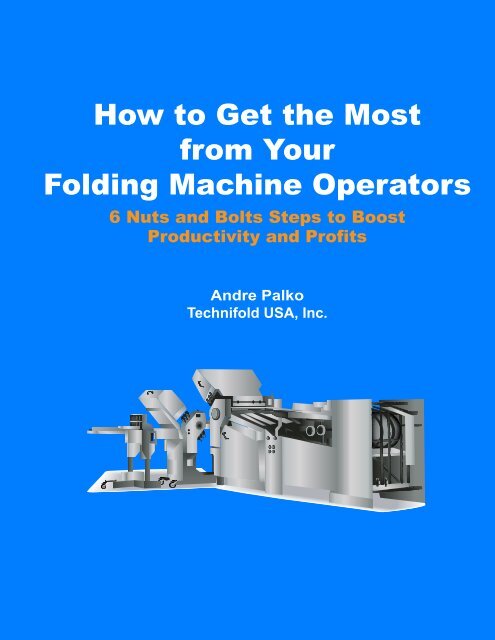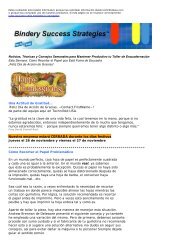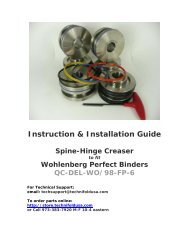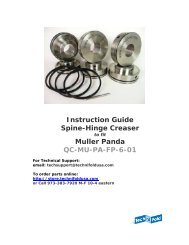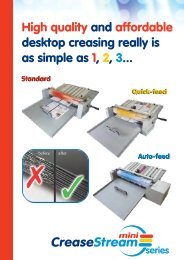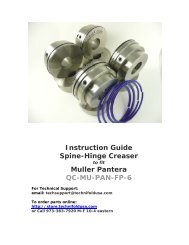How to Get the Most from Your Folding Machine ... - Technifold USA
How to Get the Most from Your Folding Machine ... - Technifold USA
How to Get the Most from Your Folding Machine ... - Technifold USA
You also want an ePaper? Increase the reach of your titles
YUMPU automatically turns print PDFs into web optimized ePapers that Google loves.
<strong>How</strong> <strong>to</strong> <strong>Get</strong> <strong>the</strong> <strong>Most</strong><br />
<strong>from</strong> <strong>Your</strong><br />
<strong>Folding</strong> <strong>Machine</strong> Opera<strong>to</strong>rs<br />
6 Nuts and Bolts Steps <strong>to</strong> Boost<br />
Productivity and Profits<br />
Andre Palko<br />
<strong>Technifold</strong> <strong>USA</strong>, Inc.
© <strong>Technifold</strong> <strong>USA</strong> 2012 All Rights Reserved<br />
Table of Contents<br />
<strong>How</strong> <strong>to</strong> <strong>Get</strong> <strong>the</strong> <strong>Most</strong> <strong>from</strong> <strong>Your</strong> <strong>Folding</strong> <strong>Machine</strong> Opera<strong>to</strong>rs - Introduction...... 1<br />
Step 1 – The 80-20 Guide <strong>to</strong> Troubleshooting ...................................................... 3<br />
Step 2 – Less is More: Why Higher Bindery Equipment Speed Does NOT<br />
Always Equal More Productivity .............................................................................. 5<br />
Step 3 – Garbage-In-Garbage-Out: Banish Feeding Issues on <strong>the</strong> <strong>Folding</strong><br />
<strong>Machine</strong> ....................................................................................................................... 7<br />
Step 4 – The Fold Rollers: Is <strong>Your</strong> Thinking Outdated? ...................................... 9<br />
Step 5 – Slitter Shafts: What Are They and Why Should I Care? .................... 12<br />
Step 6 – Putting it All Toge<strong>the</strong>r: Solid Tips <strong>from</strong> <strong>the</strong> When-Were-You Going<strong>to</strong>-Tell-Me-That<br />
Department ................................................................................... 14<br />
Implementing <strong>Your</strong> New Techniques .................................................................... 16<br />
Bindery Success Strategies eNewsletter ......................................................... 16<br />
About <strong>the</strong> Author ...................................................................................................... 17<br />
Free Bindery Productivity Resources.................................................................... 18<br />
Troubleshooting Checklist: Must-Do Items for Right Angle Signature <strong>Folding</strong><br />
..................................................................................................................................... 20
<strong>How</strong> <strong>to</strong> <strong>Get</strong> <strong>the</strong> <strong>Most</strong> <strong>from</strong> <strong>Your</strong> <strong>Folding</strong> <strong>Machine</strong><br />
Opera<strong>to</strong>rs - Introduction<br />
So your new folder opera<strong>to</strong>r has been <strong>to</strong> folder school and has a couple<br />
years of experience under <strong>the</strong>ir belt. The folder mechanic or colleagues at<br />
work have shown him or her a few tricks,<br />
but <strong>the</strong>y’re not even close <strong>to</strong> <strong>the</strong><br />
production output promised by <strong>the</strong><br />
folding machine salesman.<br />
Or perhaps your opera<strong>to</strong>r has 20 years<br />
of experience but you have <strong>the</strong> nagging<br />
suspicion that you’re not getting<br />
everything you should be getting <strong>from</strong><br />
your folding machine, even though he is a hard worker.<br />
Maybe you’re <strong>the</strong> folder opera<strong>to</strong>r and you feel your boss is giving you<br />
impossible deadlines.<br />
Whatever your scenario, you know its time <strong>to</strong> step it up <strong>to</strong> <strong>the</strong> next level of<br />
productivity on this important piece of bindery equipment. These days you<br />
can’t afford <strong>to</strong> get less than maximum productivity <strong>from</strong> every single piece of<br />
equipment in your shop.<br />
In providing solutions <strong>to</strong> make bindery equipment<br />
more productive for thousands of printing and bindery<br />
companies around <strong>the</strong> globe, we couldn’t help but<br />
notice lots of excellent bindery practices. We also<br />
witness far <strong>to</strong>o many sloppy, unproductive habits that<br />
rob everyone involved of any chance at success.<br />
One critical trait stands out in <strong>the</strong> good opera<strong>to</strong>rs, as<br />
fast and productive as <strong>the</strong>y might be, is <strong>the</strong>y never<br />
s<strong>to</strong>p trying <strong>to</strong> improve. Never. It’s in this spirit of<br />
continuous education and improvement that we put this book <strong>to</strong>ge<strong>the</strong>r.<br />
© <strong>Technifold</strong> <strong>USA</strong> 2012 All Rights Reserved 1
The point of our book is this--you can indeed get more <strong>from</strong> your folding<br />
machine at any level of experience whe<strong>the</strong>r you are <strong>the</strong> owner, supervisor or<br />
opera<strong>to</strong>r.<br />
Here are 6 simple steps which when unders<strong>to</strong>od and put in <strong>to</strong> practice,<br />
are guaranteed <strong>to</strong> boost folding machine productivity significantly.<br />
These ideas are culled <strong>from</strong> decades of hands-on experience by <strong>the</strong> staff of<br />
<strong>Technifold</strong>, <strong>from</strong> our cus<strong>to</strong>mers and <strong>from</strong> loyal Bindery Success readers.<br />
They’re easy <strong>to</strong> implement and cost nothing but a few minutes of your time,<br />
yet can have a significant impact on operations. If you find that you’ve already<br />
implemented <strong>the</strong>se ideas or you find yourself disagreeing with <strong>the</strong>m<br />
al<strong>to</strong>ge<strong>the</strong>r, I believe <strong>the</strong> book will at least inspire you <strong>to</strong> search out your own<br />
new level of productivity.<br />
© <strong>Technifold</strong> <strong>USA</strong> 2012 All Rights Reserved 2
Step 1 – The 80-20 Guide <strong>to</strong> Troubleshooting<br />
This could arguably be <strong>the</strong> most important step <strong>to</strong> learn as an<br />
apprentice folder opera<strong>to</strong>r. The folding machine can be overwhelming <strong>to</strong> a<br />
new opera<strong>to</strong>r with its high-speed array of moving, complex parts. With <strong>the</strong><br />
right mindset and systematic approach, it doesn’t need <strong>to</strong> be scary at all.<br />
© <strong>Technifold</strong> <strong>USA</strong> 2012 All Rights Reserved 3<br />
For <strong>the</strong> more experienced opera<strong>to</strong>rs, <strong>the</strong> 80-20<br />
rule can help fine tune skills even fur<strong>the</strong>r.<br />
Also known as <strong>the</strong> Pare<strong>to</strong> Principle after<br />
Italian economist Vilfredo Pare<strong>to</strong>, <strong>the</strong> general idea is that 80% of <strong>the</strong><br />
effects come <strong>from</strong> 20% of <strong>the</strong> causes. It's also referred <strong>to</strong> as <strong>the</strong> "vital few<br />
and <strong>the</strong> trivial many."<br />
Some examples:<br />
• 80% of your sales come <strong>from</strong> 20% of clients<br />
• 80% of staff problems come <strong>from</strong> 20% of <strong>the</strong> staff<br />
• 80% of production output comes <strong>from</strong> 20% of <strong>the</strong> staff<br />
• 20% of what you do each day generates 80% of your output<br />
Take a look at <strong>the</strong> activities in your work or personal life and you’ll be<br />
surprised at how often this principle appears, even when we’re talking about<br />
folding machines and bindery operations!<br />
Many years ago as a bindery department manager, I unknowingly used this<br />
'law of <strong>the</strong> vital few' <strong>to</strong> help me with folding machine and general print<br />
finishing production. I noticed that whenever opera<strong>to</strong>rs came <strong>to</strong> me with<br />
problems, <strong>the</strong> majority of problems (probably 80%) could be narrowed<br />
down <strong>to</strong> a few basic troubleshooting items.
For instance, when running 16pp<br />
signatures on our MBO or Baum<br />
folders, I knew <strong>from</strong> experience that<br />
80% of problems originated with 3<br />
basic items: folding register, fold<br />
squareness, or perf inconsistency in<br />
<strong>the</strong> main parallel section (and <strong>the</strong>se<br />
were probably about 20% of <strong>the</strong><br />
possible causes.) Anyone who has ever run a large folding machine knows<br />
<strong>the</strong>re are dozens, if not hundreds of variables that affect a job, and it’s<br />
especially frustrating <strong>to</strong> an opera<strong>to</strong>r new <strong>to</strong> producing 16 page signatures.<br />
While <strong>the</strong> folder opera<strong>to</strong>r might claim he had a register problem in <strong>the</strong> last<br />
16pp section—because it looked that way at first glance—in most cases it<br />
was a problem in <strong>the</strong> first section. No matter what, I'd first have <strong>the</strong> opera<strong>to</strong>r<br />
check <strong>the</strong>se 'vital few' items in <strong>the</strong> parallel<br />
section.<br />
(Here are two blog posts with tips on running<br />
16 page signatures. Click Links <strong>to</strong> access.)<br />
What’s <strong>the</strong> Best Technique for 16 Pagers?<br />
3 Tips for Perforating 16 Page Signatures<br />
In most cases, <strong>the</strong> problem was solved without me ever having <strong>to</strong> set foot<br />
near <strong>the</strong> folding machine. 80% of <strong>the</strong> time, <strong>the</strong> root cause could be traced <strong>to</strong><br />
that 20% short list. The net effect was that instead of walking over <strong>to</strong> <strong>the</strong><br />
folding machine five out of five times <strong>to</strong> help with a problem, I only had <strong>to</strong> walk<br />
over one out of five times (20%.)<br />
A Basics Checklist (you’ll find one at <strong>the</strong> end of this book) became a superb<br />
training aid for new opera<strong>to</strong>rs as well as a huge productivity booster. As <strong>the</strong><br />
opera<strong>to</strong>r learned <strong>to</strong> start with his "basics checklist," <strong>the</strong> number of requests<br />
for troubleshooting help declined. That made <strong>the</strong> opera<strong>to</strong>r more productive,<br />
and it freed up my time <strong>to</strong> make me more productive. Dealing with <strong>the</strong>se vital<br />
few problems first was <strong>the</strong> key.<br />
© <strong>Technifold</strong> <strong>USA</strong> 2012 All Rights Reserved 4
Step 2 – Less is More: Why Higher Bindery Equipment<br />
Speed Does NOT Always Equal More Productivity<br />
You might think that a discussion about folding machine productivity<br />
could never be heated. Think again! In my early years with a commercial<br />
printing company, <strong>the</strong> subject of folder speed versus productivity was divisive,<br />
causing lengthy discussion and loud disagreement among folder opera<strong>to</strong>rs<br />
and shop management.<br />
Since man began putting ink on paper, one of <strong>the</strong><br />
driving-force questions has always been “<strong>How</strong> can<br />
we do this faster?” Answers <strong>to</strong> that question have<br />
led <strong>to</strong> remarkable new technologies in printing and bindery equipment and<br />
<strong>the</strong>re is always something faster and better on <strong>the</strong> horizon.<br />
The big disagreement would arise however, over how <strong>to</strong> get <strong>the</strong> maximum<br />
productivity <strong>from</strong> <strong>the</strong> varied bindery equipment at hand. The "experienced"<br />
opera<strong>to</strong>rs steadfastly insisted, <strong>to</strong> <strong>the</strong> point of becoming red-faced, that you<br />
simply had <strong>to</strong> crank up <strong>the</strong> speed control and run <strong>the</strong> machine as fast as it<br />
would possibly run. It didn’t matter if you had <strong>to</strong> s<strong>to</strong>p frequently for reloading<br />
or for clearing paper jams.<br />
I argued that if you ran <strong>the</strong> machine at <strong>the</strong> maximum non-s<strong>to</strong>p speed<br />
possible, <strong>the</strong> yield at <strong>the</strong> end of <strong>the</strong> shift would be greater than <strong>the</strong>ir crank-itup-<strong>to</strong>-10<br />
effort. If for example, you were <strong>to</strong> run <strong>the</strong> folder at 4000 sheets an<br />
hour without having <strong>to</strong> s<strong>to</strong>p <strong>to</strong> reload, <strong>to</strong> catch up on <strong>the</strong> delivery, <strong>to</strong> make<br />
adjustments, <strong>the</strong>n you would get more done than <strong>the</strong> guy who turned <strong>the</strong><br />
machine up <strong>to</strong> 6000 sheets an hour but had <strong>to</strong> s<strong>to</strong>p every few minutes <strong>to</strong> take<br />
care of something. They were confusing machine speed with productivity.<br />
Kevin Carey of DieInfo.com writes about machine productivity in his ABC’s<br />
of Diemaking & Diecutting, “almost anyone can run a press [or folding<br />
machine in our case] at its slowest speed, but far fewer can run <strong>the</strong><br />
© <strong>Technifold</strong> <strong>USA</strong> 2012 All Rights Reserved 5
press at its maximum speed. Increasing speed exposes weaknesses in<br />
methods, in practices, in <strong>to</strong>ols, in technology, in organization, and in<br />
knowledge, skill and experience.”<br />
© <strong>Technifold</strong> <strong>USA</strong> 2012 All Rights Reserved 6<br />
Notice <strong>the</strong>re are at least 8 variables mentioned that<br />
directly affect <strong>the</strong> speed at which any given opera<strong>to</strong>r<br />
can run a machine. In o<strong>the</strong>r words, running at a<br />
maximum speed will expose each and every flaw in<br />
opera<strong>to</strong>r, machine and work methods, <strong>to</strong> <strong>the</strong> point it will<br />
have a negative impact on productivity.<br />
So Who Was Right?<br />
The only way <strong>to</strong> resolve such disagreement is of<br />
course <strong>to</strong> see who produces <strong>the</strong> most per shift over a<br />
period of time. This particular printing company had an<br />
IT guy who could track how many breaths we <strong>to</strong>ok in a<br />
day, number of sheets folded, number of sheets wasted<br />
and most importantly, our average daily production for any given time frame.<br />
It was impressive, considering he did this back in <strong>the</strong> pre-personal computer<br />
days of punch cards.<br />
The result: It was a hard lesson for <strong>the</strong> old-timers who believed <strong>the</strong>y<br />
were running <strong>the</strong>ir machines ‘faster.’ Their average daily production was<br />
substantially lower, month after month. It didn't matter whe<strong>the</strong>r it was <strong>the</strong><br />
brand new MBO folder or an antique Dexter. Maximum non-s<strong>to</strong>p speed was<br />
<strong>the</strong> better strategy for maximum yield.<br />
The challenge of course is that such an effort requires personal<br />
responsibility. It would be easy for a lazy opera<strong>to</strong>r <strong>to</strong> loaf along at what he<br />
claims is his maximum non-s<strong>to</strong>p speed. Even <strong>the</strong> diligent, responsible<br />
opera<strong>to</strong>r could, as Carey says, “find a comfort zone or a sweet spot and<br />
prematurely settle in<strong>to</strong> that mode.”<br />
So in our relentless pursuit for a faster speed which truly yields greater<br />
productivity, <strong>the</strong> question for you is two-fold: how fast are you, (you do know,<br />
don’t you?) and what are you doing about becoming faster?
Step 3 – Garbage-In-Garbage-Out: Banish Feeding<br />
Issues on <strong>the</strong> <strong>Folding</strong> <strong>Machine</strong><br />
The idea of garbage-in-garbage-out seems self-evident but it's not<br />
necessarily so <strong>to</strong> <strong>the</strong> folder opera<strong>to</strong>r who carelessly loads his machine and<br />
<strong>the</strong>n wonders why it isn’t feeding smoothly.<br />
If <strong>the</strong> folder isn't feeding consistently and without s<strong>to</strong>ps, it will be <strong>to</strong>ugh <strong>to</strong> get<br />
good register and fold quality. Here are some items that contribute <strong>to</strong> feeding<br />
problems.<br />
Loading problems<br />
This is simply opera<strong>to</strong>r error, typically<br />
found in inexperienced opera<strong>to</strong>rs who<br />
can't consistently fan <strong>the</strong> sheets for a<br />
continuous feeder or jog <strong>the</strong>m correctly<br />
for a pile feeder.<br />
Pressroom issues<br />
You may find that <strong>the</strong> sheets come <strong>from</strong><br />
<strong>the</strong> press with hidden problems.<br />
• Sheets are poorly jogged<br />
• Sheets stuck <strong>to</strong>ge<strong>the</strong>r due <strong>to</strong> water problems, coatings,<br />
varnishes or improper drying<br />
Paper problems<br />
• Sheets are not square. This is not so bad if <strong>the</strong> entire job is printed<br />
with sheets oriented <strong>the</strong> same way. If <strong>the</strong>y're turned or flipped <strong>the</strong>n<br />
you have a 'register' problem that is difficult <strong>to</strong> fix. Sheets<br />
inconsistently skewed may register OK on <strong>the</strong> printing press, but a<br />
© <strong>Technifold</strong> <strong>USA</strong> 2012 All Rights Reserved 7
uckle folder will be s<strong>to</strong>pped frequently for 'fold' adjustments every<br />
time <strong>the</strong> paper changes.<br />
• Sheets are different sizes. Best fix is <strong>to</strong> trim before printing, for <strong>the</strong><br />
sake of both press and folding operations. If <strong>the</strong> pressman printed it<br />
without issues, in <strong>the</strong>ory you can get good register...IF you can feed it<br />
without doubles!<br />
• Sheets are badly curled. When you can't get it <strong>to</strong> run on <strong>the</strong> folder<br />
try flipping <strong>the</strong> sheet or remove <strong>the</strong> curl by hand.<br />
Folder setup incorrectly<br />
The key is <strong>to</strong> recognize such problems before time is wasted. Setup should<br />
always be systematic so that no important item is left out. Experienced<br />
opera<strong>to</strong>rs have <strong>the</strong>ir own mental checklist <strong>the</strong>y follow every time but <strong>the</strong> new<br />
opera<strong>to</strong>r may need <strong>to</strong> use an actual checklist.<br />
For instance: an opera<strong>to</strong>r forgets <strong>to</strong> adjust <strong>the</strong> vacuum and <strong>the</strong> sheets are<br />
feeding inconsistently. He continues <strong>to</strong> set up a complex job and runs in<strong>to</strong><br />
various “register problems.” Valuable machine time is wasted trying <strong>to</strong> fix <strong>the</strong><br />
wrong problems instead of <strong>the</strong> basic vacuum problem.<br />
If feeding problems persist on a regular basis, <strong>the</strong>n it’s time <strong>to</strong> isolate<br />
<strong>the</strong> cause and do what’s needed <strong>to</strong> correct it.<br />
© <strong>Technifold</strong> <strong>USA</strong> 2012 All Rights Reserved 8
Step 4 – The Fold Rollers: Is <strong>Your</strong> Thinking Outdated?<br />
Perhaps you wince at <strong>the</strong> thought of replacing fold rollers. “What...spend<br />
thousands of dollars on recovering rollers?? Nah, just stick some tape on<br />
<strong>the</strong>m and we'll be fine.”<br />
© <strong>Technifold</strong> <strong>USA</strong> 2012 All Rights Reserved 9<br />
You might ‘get by’ with a cheap solution like this but<br />
your bindery operation will never be competitive. If<br />
investing in folder productivity <strong>to</strong> this extent leaves you<br />
feeling squeamish, here are four tips that should help<br />
you get over it.<br />
Change your mindset. Think of fold rollers as a<br />
consumable item. The fold rollers are <strong>the</strong> heart of <strong>the</strong><br />
folding machine and most <strong>to</strong>day are made <strong>from</strong> a<br />
combination of steel and urethane or rubber. They will<br />
wear out with use; <strong>the</strong>re is no way around it.<br />
Consider how well <strong>the</strong> machine runs with new rollers…<br />
• Make-ready is much faster with few adjustments needed<br />
• Paper jams decrease and <strong>the</strong>re is less waste<br />
• Quality is better<br />
• Run speeds are higher<br />
Roller wear is slow and it takes an insidious, almost unnoticeable <strong>to</strong>ll on<br />
productivity. That partially accounts for <strong>the</strong> reluctance of many owners <strong>to</strong><br />
replace <strong>the</strong>m.<br />
If you track production, worn rollers take <strong>the</strong> form of decreased production. If<br />
you don’t track it directly, you’ll notice that you’re working harder with more<br />
overtime. For a high-volume folding operation, a loss of even 5-10% fewer<br />
sheets per month equals a big loss of time and money over <strong>the</strong> course of <strong>the</strong><br />
year, probably far more than <strong>the</strong> cost of roller upkeep.
To check if rollers need replacement, insert a strip of light text s<strong>to</strong>ck at each<br />
end of <strong>the</strong> roller and set evenly for a light drag. Then insert 3 strips, one at<br />
each end and one in <strong>the</strong> middle. If <strong>the</strong> middle sheet has no grip, it’s time for<br />
new rollers.<br />
Follow manufacturers’ directions for setting <strong>the</strong> rollers<br />
• It only takes a few minutes <strong>to</strong> set with calipers<br />
• It extends <strong>the</strong> life of <strong>the</strong> rollers<br />
• It improves quality overall<br />
• You can always 'cheat' if you need <strong>to</strong> add pressure but be sure <strong>to</strong> re-set<br />
when done<br />
Ask five folding machine opera<strong>to</strong>rs how <strong>to</strong> set <strong>the</strong> rollers and you’ll probably<br />
get five opinions. The best starting point is with what <strong>the</strong> manufacturer<br />
suggests. Later, if experience dictates o<strong>the</strong>rwise, you can change <strong>the</strong> setup<br />
procedure.<br />
For instance, one popular notion is that <strong>the</strong> strips of paper have <strong>to</strong> be cut<br />
neatly <strong>to</strong> insert in <strong>the</strong> calipers. According <strong>to</strong> Alfred Furler’s 1983 book <strong>Folding</strong><br />
in Practice, when adjusting fold roller tension on a Stahl “<strong>the</strong> adjustment<br />
strips must be inserted as folded and not as single strips”. That’s how Stahl<br />
designed <strong>the</strong>ir machines but o<strong>the</strong>r manufacturers' machines could differ. It<br />
pays <strong>to</strong> check since an improper setting will affect roller performance and life<br />
expectancy.<br />
Perhaps you see opera<strong>to</strong>rs skip <strong>the</strong> caliper setting procedure entirely and<br />
<strong>the</strong>n struggle throughout a folding run, when a couple minutes inserting <strong>the</strong><br />
right sheet in <strong>the</strong> calipers would have prevented <strong>the</strong> problem. I've even seen<br />
opera<strong>to</strong>rs running <strong>the</strong>ir folders with no sheets in <strong>the</strong> calipers who <strong>the</strong>n crank<br />
in excess pressure on <strong>the</strong> rollers. I never did see an upside <strong>to</strong> this and <strong>the</strong><br />
downside of course is an increase in folding problems and premature roller<br />
and bushing wear.<br />
© <strong>Technifold</strong> <strong>USA</strong> 2012 All Rights Reserved 10
Fold rollers need <strong>to</strong> remain clean <strong>to</strong> work properly<br />
Dirt, ink, powder all conspire <strong>to</strong> rob fold rollers of <strong>the</strong>ir effectiveness. A small<br />
amount of glop in <strong>the</strong> wrong place can ruin a folder opera<strong>to</strong>r’s day. When set<br />
correctly most fold rollers will stay remarkably clean but it can’t hurt <strong>to</strong> take a<br />
look at <strong>the</strong>ir condition each day and perhaps schedule a regular cleaning,<br />
using only <strong>the</strong> type of cleaner recommended for your rollers.<br />
Think of fold rollers as a <strong>to</strong>ol<br />
Let’s suppose you have one folder that always runs aqueous coated jobs<br />
and it’s a headache <strong>to</strong> do <strong>the</strong>se jobs. Consider switching fold rollers <strong>to</strong> a<br />
combo with open cell foam urethane. It's softer than standard urethane and<br />
has a better grip on slippery paper. Perhaps you run numerous glue jobs.<br />
Select <strong>from</strong> a variety of segmented glue rollers with a choice of urethane or<br />
rubber materials <strong>to</strong> suit <strong>the</strong> job.<br />
Talk <strong>to</strong> your folder manufacturer or roller supplier. There are <strong>to</strong>olboxes full of<br />
off-<strong>the</strong>-shelf and cus<strong>to</strong>m fold rollers available <strong>to</strong> suit any application.<br />
An additional benefit: improved fold roller performance means better<br />
scoring, perforating and trimming functions. If you do a little honest numbercrunching,<br />
you’ll see that good fold roller maintenance pays for itself, and it’s<br />
a guaranteed way <strong>to</strong> keep your bindery department productive.<br />
© <strong>Technifold</strong> <strong>USA</strong> 2012 All Rights Reserved 11
Step 5 – Slitter Shafts: What Are They and Why<br />
Should I Care?<br />
These days <strong>the</strong>re are numerous scoring, cutting and perforating <strong>to</strong>ols<br />
designed <strong>to</strong> fit <strong>the</strong> slitter shafts of folding machines, scoring machines, saddle<br />
stitchers, perfect binders, folder gluers and more.<br />
When I was introduced <strong>to</strong> bindery work in <strong>the</strong> late 1970's <strong>the</strong> slitter shafts<br />
were seen as a vehicle for moving <strong>the</strong> sheet in<strong>to</strong> <strong>the</strong> cross carrier or on<strong>to</strong> <strong>the</strong><br />
delivery table. A perf or cut applied <strong>to</strong> <strong>the</strong> sheet was typically done for<br />
signature work, which would trim off later in <strong>the</strong> finishing process. A score<br />
simply aided <strong>the</strong> folding of brochures and creasing was unheard of; you did<br />
that on a die cutter or press. Occasionally a low-quality throwaway brochure<br />
would be trimmed on <strong>the</strong> folder.<br />
Slitter shafts would take years of punishment before <strong>the</strong>re was any thought<br />
of replacing a bearing, never mind <strong>the</strong> shafts <strong>the</strong>mselves. They just weren't<br />
THAT critical <strong>to</strong> <strong>the</strong> folding operation. Today it's different. Creasing, micro<br />
perforating and high-quality trimming all happen on <strong>the</strong> slitter shafts. Lots of<br />
finished product comes off <strong>the</strong> folder. (The name 'slitter shaft' remains,<br />
despite <strong>the</strong> multiple uses of <strong>to</strong>ols applied <strong>to</strong> <strong>the</strong>m.)<br />
The <strong>to</strong>ols that fit <strong>the</strong> shafts, by <strong>the</strong>ir very nature, are precision devices and<br />
are only as good as <strong>the</strong> shafts <strong>to</strong> which <strong>the</strong>y are attached. Some slitter shaft<br />
items that affect <strong>to</strong>ol performance:<br />
• Bent shafts - <strong>to</strong>ols 'bounce' up and down, thus losing precision and<br />
effectiveness<br />
• Dings and severe scratches - <strong>to</strong>ols can't be freely moved, limiting<br />
function of free-floating devices and making setup difficult.<br />
• Worn bushings or bearings - increases shaft movement which reduces<br />
effectiveness of precision <strong>to</strong>ols<br />
© <strong>Technifold</strong> <strong>USA</strong> 2012 All Rights Reserved 12
Today <strong>the</strong>y are central <strong>to</strong> folding machine production. Major manufacturers<br />
even make slitter shaft make-ready tables and cabinets.<br />
The goal:<br />
1. Reduce make-ready time.<br />
2. <strong>Get</strong> maximum value <strong>from</strong> experienced opera<strong>to</strong>rs by putting <strong>the</strong>m <strong>to</strong><br />
work in <strong>the</strong> critical <strong>to</strong>ol setup area.<br />
Remember <strong>the</strong>n, that slitter shafts are as important as <strong>the</strong> fold rollers. Don’t<br />
overlook <strong>the</strong>m.<br />
Here a two related Bindery Success Blog tips<br />
that you might find helpful.<br />
Click <strong>the</strong> Links <strong>to</strong> read <strong>the</strong>m online.<br />
1) Simple Slitter Shaft Checkup for <strong>Your</strong> <strong>Folding</strong> <strong>Machine</strong><br />
2) Slitter Shaft Setup<br />
© <strong>Technifold</strong> <strong>USA</strong> 2012 All Rights Reserved 13
Step 6 – Putting it All Toge<strong>the</strong>r: Solid Tips <strong>from</strong> <strong>the</strong><br />
When-Were-You Going-<strong>to</strong>-Tell-Me-That Department<br />
In my early years as a bindery apprentice with a good understanding of<br />
basics and a positive, eager mindset, I’d occasionally encounter a problem<br />
that caused <strong>the</strong> shedding of some blood, sweat and tears. It was usually at<br />
that point that an old-timer would say, “Hey, all you have <strong>to</strong> do is tweak <strong>the</strong><br />
whatchamacallit <strong>to</strong> fix that problem.”<br />
In <strong>the</strong> interest of saving you and your opera<strong>to</strong>rs unnecessary grief (is it ever<br />
necessary?) here are some advanced tips <strong>to</strong> keep it all running smoothly.<br />
1) Use <strong>the</strong> deflec<strong>to</strong>rs <strong>to</strong> keep your perf or scores running straight.<br />
If your score or perf is crooked—but in a consistent position—this technique<br />
will almost always fix it.<br />
One side of <strong>the</strong> sheet is traveling <strong>to</strong>o<br />
fast through <strong>the</strong> fold rollers.<br />
(Exaggerated in <strong>the</strong> illustration at right)<br />
You can slow <strong>the</strong> ‘fast’ side by cocking a<br />
fold plate (with closed deflec<strong>to</strong>r) on <strong>the</strong><br />
side that you want <strong>to</strong> slow down.<br />
Usually plate 3 or 4 is used, but you<br />
can use any fold plate as long as it's one that is after <strong>the</strong> fold, if any. Unlock<br />
<strong>the</strong> fold plate that side, pull it out about 1/16" and re-lock. Repeat until score<br />
is straight. For severe problems, use two fold plates, with a little adjustment<br />
on each plate.<br />
2) Running signature work?<br />
• Leave <strong>the</strong> press guide and gripper on <strong>the</strong> sheet<br />
• Perf <strong>the</strong> head (16pp) or face (32 pp) Click Here for a related article on<br />
perforating or go <strong>to</strong> technifoldusa.com and search “16 page<br />
signatures.”<br />
© <strong>Technifold</strong> <strong>USA</strong> 2012 All Rights Reserved 14
© <strong>Technifold</strong> <strong>USA</strong> 2012 All Rights Reserved 15<br />
Click Here for some tips for perforating<br />
16 page sigs or use <strong>the</strong> same search<br />
term as above.<br />
• Trim <strong>the</strong> foot and <strong>the</strong> face of <strong>the</strong><br />
signature on <strong>the</strong> folder and not on <strong>the</strong><br />
guillotine. You’ll get better register and<br />
have better control over <strong>the</strong> folding.<br />
3) Use this amazingly easy technique <strong>to</strong> get rid of dog ears on folded<br />
brochures.<br />
Click Here for a simple technique <strong>from</strong> <strong>the</strong><br />
Bindery Success Blog or go <strong>to</strong> technifoldusa.com<br />
and search “eliminate bent corners” <strong>to</strong> pull up <strong>the</strong><br />
blog post.<br />
This is probably my all-time favorite technique. When I first discovered it, I<br />
couldn’t wait <strong>to</strong> do my next letter-fold job!<br />
4) Don’t overload <strong>the</strong> slitter shafts with pull out wheels<br />
This is ano<strong>the</strong>r good example of less being more. Click Here <strong>to</strong> do directly <strong>to</strong><br />
<strong>the</strong> tip at BinderySuccessBlog.com or search “slitter shaft setup” at<br />
www.technifoldusa.com<br />
5) When folding right angle work, always take time <strong>to</strong> ensure <strong>the</strong> main<br />
parallel section is folding, trimming, perforating or scoring correctly<br />
before you troubleshoot elsewhere! It only takes seconds <strong>to</strong> do a quick<br />
check of <strong>the</strong> first section but it instantly narrows down <strong>the</strong> pool of causes for<br />
whatever is ailing your folder.
Implementing <strong>Your</strong> New Techniques<br />
If you are <strong>the</strong> folder opera<strong>to</strong>r, <strong>the</strong>n changing your specific folding machine<br />
techniques is simple. The fact that you’re reading this tells me you’re open <strong>to</strong><br />
new ideas, so it’s a matter of trying <strong>the</strong>m out on your next job. If, like most of<br />
us, you’re somewhat resistant <strong>to</strong> change, <strong>the</strong>n you have a bit of an inside job<br />
<strong>to</strong> do first! But that is precisely where you’ll find your biggest rewards, just<br />
outside your comfort zone!<br />
If you are a manager or supervisor, whe<strong>the</strong>r for a<br />
staff of one or one hundred, you have <strong>the</strong> added step of<br />
getting opera<strong>to</strong>rs <strong>to</strong> “buy in” <strong>to</strong> your new<br />
recommendations. To inspire o<strong>the</strong>rs you must first<br />
inspire yourself. That means being a believer, not so<br />
much in <strong>the</strong> specifics of this book but in <strong>the</strong> fact that<br />
lots of small, incremental changes can indeed make a<br />
big difference in long-term productivity.<br />
If you can accept that fact, <strong>the</strong>n endorsing a bit of experimentation for <strong>the</strong><br />
sake of improvement is a no-brainer. The upside: improved folding machine<br />
productivity and quality. The cost; just a little bit of your time and your<br />
opera<strong>to</strong>r’s time, time that you might currently be squandering every day in <strong>the</strong><br />
form of lost productivity.<br />
Bindery Success Strategies eNewsletter<br />
Be sure <strong>to</strong> sign up for <strong>Technifold</strong>’s weekly Bindery<br />
Success Strategies eNewsletter. It contains<br />
ongoing bindery equipment tips, strategies, news<br />
and product updates <strong>to</strong> make life easier for bindery<br />
veteran and new hire alike. There is no cost <strong>to</strong> you<br />
or your staff.<br />
Bindery Success Strategies is a great <strong>to</strong>ol <strong>to</strong><br />
reinforce and review your implementation of new<br />
techniques and practices. Click Here <strong>to</strong> sign up<br />
<strong>to</strong>day or visit<br />
http://www.technifoldusa.com/free-resources/free-enewsletter/<br />
© <strong>Technifold</strong> <strong>USA</strong> 2012 All Rights Reserved 16
About <strong>the</strong> Author<br />
Andre Palko was bitten by <strong>the</strong> entrepreneurial bug at age 12 when he began<br />
selling flower seeds and delivering grocery s<strong>to</strong>re flyers door-<strong>to</strong>-door in his<br />
home<strong>to</strong>wn of Frederick, MD. His intro <strong>to</strong> <strong>the</strong> printing<br />
industry came while he was playing bass guitar for a<br />
New York City rock & roll band in 1980. The bands<br />
lead singer and songwriter was part of a family printing<br />
business and it wasn’t long before Andre was packing<br />
boxes, running a folding machine, and learning <strong>the</strong><br />
printing and bindery trade by day, while taking classes<br />
at Columbia University and playing clubs by night.<br />
Rock and roll didn’t pay <strong>the</strong> bills so Andre stuck with <strong>the</strong> print industry,<br />
including a stint as owner/opera<strong>to</strong>r of a trade bindery as well as manager of a<br />
small commercial printing and copy operation. It was <strong>the</strong>se 20+ years of<br />
hands-on operational and managerial experience that laid <strong>the</strong> foundation for<br />
<strong>the</strong> opportunity he seized on in 2002 in <strong>the</strong> form of a little-known folding<br />
machine device called <strong>the</strong> Tri-Creaser.<br />
Andre <strong>to</strong>ok <strong>the</strong> opportunity and ran with it, and <strong>to</strong>day is President of<br />
<strong>Technifold</strong> <strong>USA</strong>, Inc. The independently owned company provides patented<br />
solutions and unique strategies that enable printers <strong>to</strong> get up <strong>to</strong> twice <strong>the</strong>ir<br />
normal yield <strong>from</strong> bindery and finishing equipment. Their cus<strong>to</strong>mers include<br />
<strong>the</strong> <strong>to</strong>p printing companies and finishing equipment manufacturers in <strong>the</strong><br />
world.<br />
Andre’s success at making printing and bindery<br />
companies more productive propelled <strong>Technifold</strong><br />
<strong>USA</strong> <strong>to</strong> <strong>the</strong> ranks of <strong>the</strong> Inc. 5000 in 2009,<br />
gaining national recognition as one of <strong>the</strong><br />
fastest growing private companies in America.<br />
This notable achievement comes at time when<br />
many businesses in this and o<strong>the</strong>r industries are<br />
shrinking.<br />
For fun he pilots a Cessna 172 aircraft and musically has moved <strong>from</strong> <strong>the</strong><br />
likes of New York clubs such as <strong>the</strong> famed CBGB’s <strong>to</strong> <strong>the</strong> church hall, playing<br />
bass and singing with a contemporary choir throughout New Jersey and with<br />
his church choir every Sunday.<br />
© <strong>Technifold</strong> <strong>USA</strong> 2012 All Rights Reserved 17
Free Bindery Productivity Resources<br />
Be sure <strong>to</strong> take advantage of <strong>the</strong> 8 free bindery resources available <strong>to</strong> you,<br />
courtesy of <strong>Technifold</strong> <strong>USA</strong>.<br />
Go online <strong>to</strong> http://www.<strong>Technifold</strong><strong>USA</strong>.com/free-resources or click <strong>the</strong><br />
images below.<br />
© <strong>Technifold</strong> <strong>USA</strong> 2012 All Rights Reserved 18
© <strong>Technifold</strong> <strong>USA</strong> 2012 All Rights Reserved 19
Troubleshooting Checklist: Must-Do Items for Right<br />
Angle Signature <strong>Folding</strong><br />
This checklist is intended <strong>to</strong> speed up troubleshooting on 16pp and o<strong>the</strong>r<br />
signature work, primarily when using right angle fold units or knife folders. It's<br />
not a comprehensive guide on how <strong>to</strong> set up your particular folder. Refer <strong>to</strong><br />
your manufacturer's directions for more details.<br />
Check These Items First<br />
� Fold #1 registers in correct position with regard <strong>to</strong> lineups<br />
(crossovers) and bleeds. Note: Sometimes you have <strong>to</strong> fold a sheet in a<br />
skewed position <strong>to</strong> get crossovers and bleeds <strong>to</strong> line up, especially when<br />
dealing with full press sheets. Whatever <strong>the</strong> case, be sure it is 100%<br />
consistent.<br />
� Perf is square <strong>to</strong> <strong>the</strong> sheet and/or <strong>the</strong> printed image<br />
� Perf is in correct position<br />
If one of <strong>the</strong> three items above isn’t right, take <strong>the</strong> time <strong>to</strong> fix it. Below are<br />
some items <strong>to</strong> check in your troubleshooting search.<br />
PAPER<br />
� Is excessive curl a problem?<br />
� Is it jogged sufficiently?<br />
� Is it stuck <strong>to</strong>ge<strong>the</strong>r?<br />
� Is it wrinkled?<br />
� Is it fanned out correctly?<br />
FEEDER<br />
� Is it feeding consistently?<br />
� Is it set correctly?<br />
� Is <strong>the</strong> pile height correct? (pile feeders)<br />
� Is <strong>the</strong> sheet advance consistently s<strong>to</strong>pping <strong>the</strong> sheet in <strong>the</strong> right<br />
position? (continuous feeders)<br />
© <strong>Technifold</strong> <strong>USA</strong> 2012 All Rights Reserved 20
� Are <strong>the</strong> sheet guides set for proper clearance?<br />
� Are front and side blowers set for proper sheet separation?<br />
� Are backs<strong>to</strong>ps and rollers in proper position on or behind paper?<br />
� Is <strong>the</strong> caliper set?<br />
� Is sheet pulling <strong>to</strong> side lay?<br />
� Is side lay registration consistent?<br />
� Is side lay square <strong>to</strong> fold roller?<br />
� Are register table belts and/or marbles correct?<br />
FOLDING SECTION<br />
� Is fold roller pressure set properly?<br />
� Are fold plates adjusted <strong>to</strong> correct length and square <strong>to</strong> sheet?<br />
� Are <strong>the</strong> fold rollers clean?<br />
� Are <strong>the</strong> slitter shafts locked properly?<br />
TOOLS<br />
� Is <strong>the</strong> correct perf being used?<br />
� Are <strong>to</strong>ols positioned correctly on slitter shaft?<br />
� Are jam detec<strong>to</strong>rs positioned and set correctly?<br />
© <strong>Technifold</strong> <strong>USA</strong> 2012 All Rights Reserved 21
For a Personalized Strategy that<br />
could save tens of thousands of<br />
dollars in YOUR shop,<br />
email info@technifoldusa.com<br />
or call 973-383-7920<br />
© <strong>Technifold</strong> <strong>USA</strong> 2012 All Rights Reserved 22


